High in the Andean mountains of Peru, the Q’eswachaka Rope Bridge stands as a remarkable symbol of Inca ingenuity and cultural endurance. This ancient bridge, woven entirely from ichu grass, spans the dramatic Apurimac River and connects more than just the two sides of a canyon—it connects us to a rich history and an enduring tradition. For over 500 years, this bridge has been meticulously reconstructed annually by local communities, showcasing their dedication to preserving this vital piece of their heritage. Visiting Q’eswachaka is not just a journey through breathtaking landscapes but a step back in time to experience living history and vibrant Andean culture.
Qeswachaka, The last handwoven Inca bridge
Qeswachaka is one of Peru's last remaining hand-made Inca bridges, constructed entirely out of woven grass, and measuring 82 meters (269 feet). Situated near Cusco Region's Qehue district and crosses the Apurimac River. Rebuilt using traditional methods every year since the Inca Empire days.
The Q'eswachaka Rope Bridge in Peru stands as one of the last remaining examples of Inca engineering and is an impressive monument to their skill and craftsmanship. Constructed entirely from hand-woven grass ropes, the bridge has been in use by local people for centuries - with annual rebuilds using methods handed down through generations. Restoring this incredible work each year stands as a testament to their skill and craftsmanship as a tribute to Inca engineering itself.
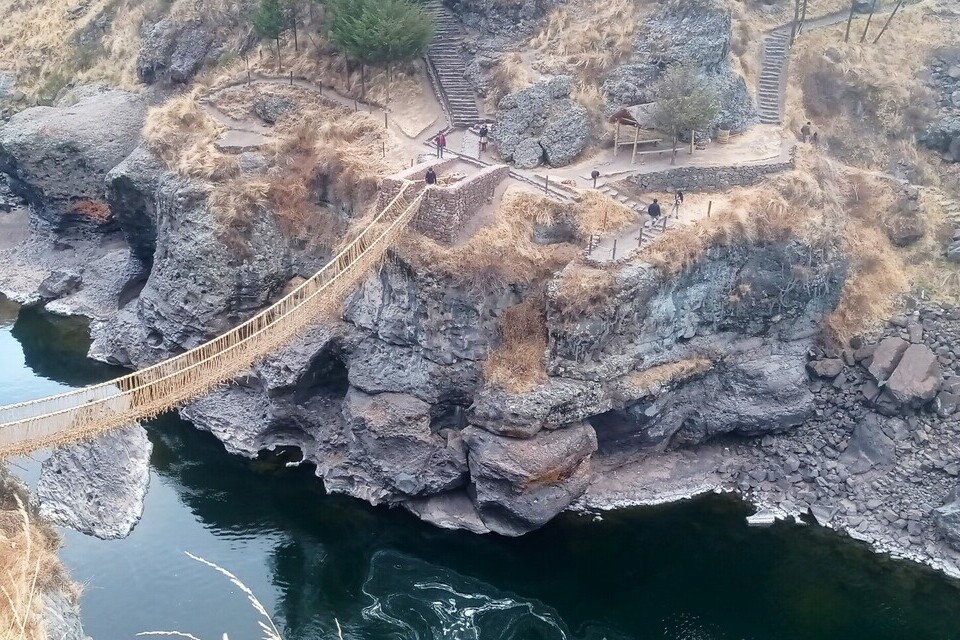
The Incas constructed suspension bridges out of rope and wooden planks to connect their villages across rivers and canyons. These ingenious constructions, held up by ropes anchored to trees on either side, allowed them to navigate their complex empire safely across challenging Andean terrain.
However, Inca suspension bridges were not particularly strong and could only support a few people at one time; too many people trying to cross at once could cause it to collapse and potentially bring disaster for all involved. Yet these bridges were indispensable, providing Incas a means of crossing their mountainous homeland's numerous rivers and canyons safely - something which continues today with annual rebuildings of the Q'eswachaka Rope Bridge to keep their engineering legacy alive.
History
The Inca Empire, famed for its engineering achievements, constructed the Q'eswachaka Rope Bridge as part of their road network Qhapaq Nan. This network connected various parts of their empire together for trade, communication, and military purposes - with Q'eswachaka Rope Bridge being an important link across challenging Andean terrain for efficient movement and control throughout their empire. Crafted out of braided ichu grass braids for durability, this bridge served as a lifeline between parts of their empire that allowed trade, communication, and military operations between parts.
The 16th-century arrival of Spanish colonizers brought significant transformation to Andean life. Inca traditions and structures were destroyed as Spanish imperialists sought to establish control. Yet one key structure survived: Q'eswachaka Rope Bridge, which was maintained by local communities who valued its practical utility and cultural significance during this turbulent era of colonial rule; its continued existence is a testament to their perseverance in upholding their heritage.
Today, the Q'eswachaka Rope Bridge continues its proud legacy under the care of descendants of its original builders. No mere historical artifact, this living tradition serves as an active component of local culture - annual rebuilds ensure knowledge and skills necessary for its construction are passed from generation to generation - keeping its remarkable tradition alive. Drawing visitors from around the globe who come to witness this combination of living heritage with history.
Location.
The Q'eswachaka Rope Bridge can be found in Huinchhiri Village within the Qehue District in the Canas Province of Cusco, Peru, about 100km (62 miles) south of Cusco City. Situated at an altitude of 3,700m (12,139ft), it spans the Apurimac River and provides breathtaking views as you traverse this remote and idyllic Andean landscape en route. Reaching Q'eswachaka will reward travelers as much as reaching their final destination!
Visitors wishing to reach the Qeswachaka Bridge must travel through the Andean highlands. Most travelers begin their journey in Cusco, the cultural and historical heart of this region. From there, organized tours typically include bus and car rides through charming Andean villages and stunning mountain landscapes, offering an immersive experience of both local culture and natural beauty.
To reach this attraction, follow the Cusco to Puno route until Combapata, turn north onto Yanaoca Road, and continue into Qehue district - this should take approximately 3.5 hours by car.
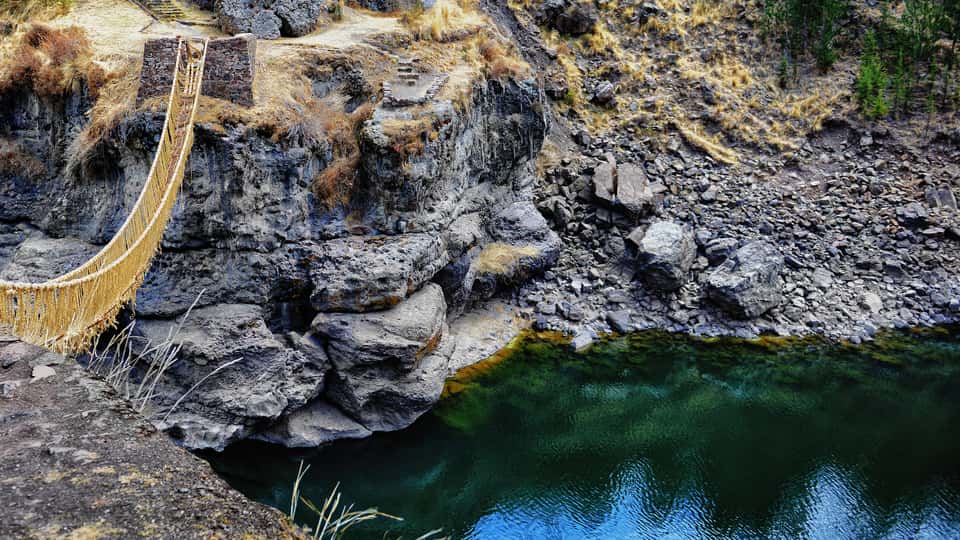
Weather
Q'eswachaka's climate is typical of high-altitude Andean regions, featuring significant day-night temperature variations. Daytime temperatures generally range between 15degC and 20degC (59degF to 68degF), while nighttime temperatures can fall close to freezing. May to September offers clear skies and mild weather—the ideal time for visitors. In contrast, October to April brings frequent rainstorms that make travel and outdoor activities more difficult.
Visit Q'eswachaka during the dry season - specifically June, when its annual rebuilding ceremony takes place - for optimal weather conditions and cultural festivities associated with its reconstruction. Clear skies and mild temperatures also enhance this experience, making it easier to explore the area while taking in breathtaking scenery.
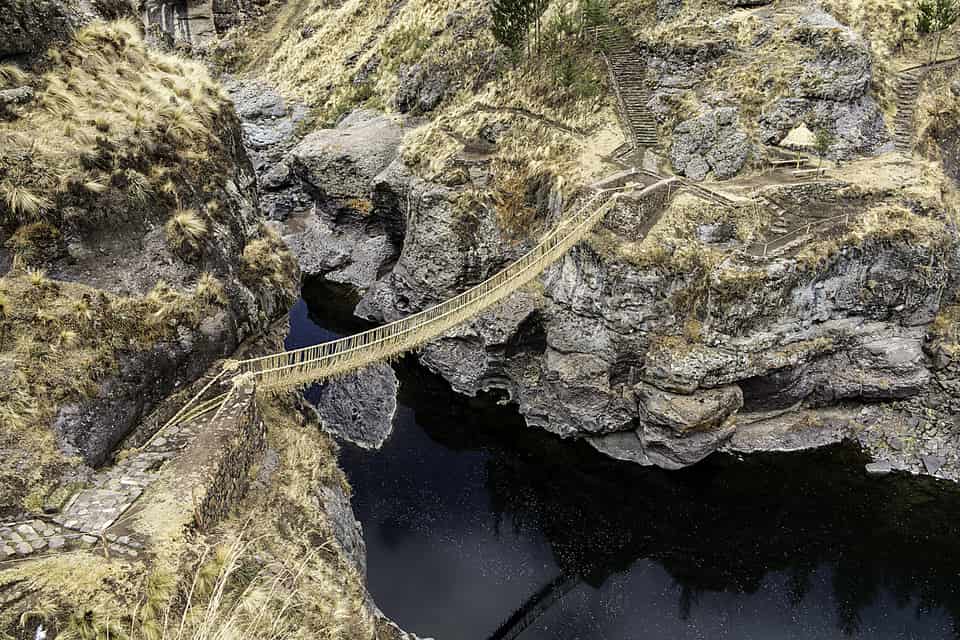
Annual Rebuilding Ceremony of Q'eswachaka Inca Bridge: Honoring Ancestral Techniques
The annual reconstruction ceremony of the Q'eswachaka Rope Bridge in the first week of June every year is an integral cultural tradition in the Canas Province of Cusco, Peru. Held annually for centuries, this vibrant celebration honors the Inca civilization by commemorating this unique feat of engineering and cultural heritage.
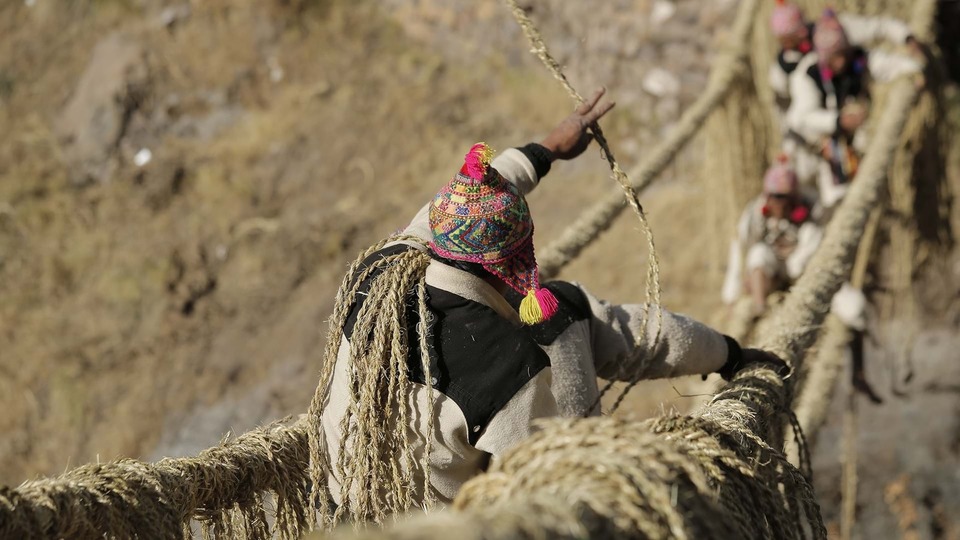
Photo by @PromPeru
Huinchiri, Chaupibanda, Choccayhua, and Ccollana Quehue are the primary communities participating in the rebuilding ceremony. Every year, they join together in an attempt to reconstruct the bridge as part of an annual ritual, reflecting Inca tradition by cooperating to build it back together again - an act that represents reciprocal labor that was central to Andean society.
Preparatory Phase
Prep work for rebuilding begins several days in advance of its actual construction. Durable high-altitude grass found in the Andes (ichu grass) is harvested, dried, and twisted into small cords, which will later form larger ropes to form bridge structural elements.
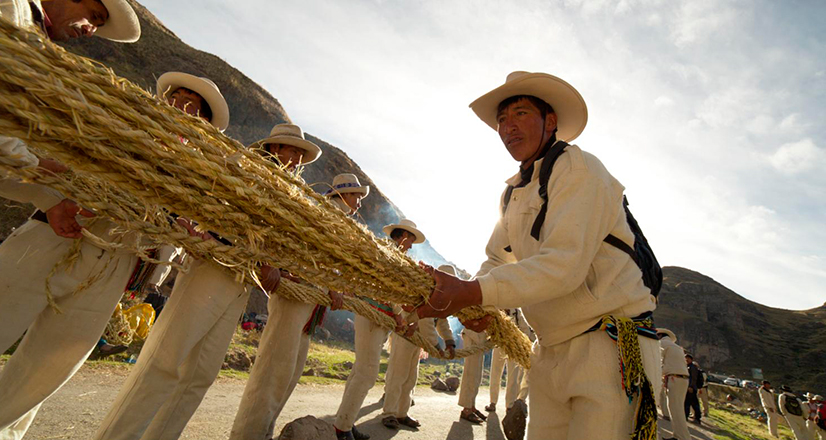
Photo by @PromPeru
Construction Phase
The construction phase of the ceremony spans over four days:
- Day 1: A ceremonial cutting down and collapse of the old bridge takes place today. Community members gather for a ritual led by an indigenous spiritual leader known as a paqo who offers prayers and offerings to Pachamama (the Earth Mother) and Apus (mountain spirits), asking them for protection and blessings during construction of the bridge.
- Day 2 and 3 are dedicated solely to building it. Thick ropes are strung across a gorge to form the basis of the bridge, with thinner ropes used to link together its main cables. Small sticks are then interwoven through these ropes in order to form its floor. Chakaruwaqs (men of the community who specialize in weaving rope bridges) are charged with securing these ropes and weaving the bridge on day 4.
- Day 4: On this final day of celebrations. Once a bridge is constructed, its strength is tested, followed by a celebratory event where traditional music, dance, and food will be performed by local community leaders and featured as part of an elaborate festival ceremony. Finally, public access to the bridge begins through an opening crossing led by its paqo and other leaders from within its vicinity.
Cultural Significance
Rebuilding ceremonies of Q'eswachaka Bridge are more than simply maintenance; they represent a deep expression of cultural identity and continuity. They bring together various aspects of Inca heritage—engineering, craftsmanship, spirituality, and communal cooperation—for an event that truly honors its meaning and importance.
UNESCO Recognition
Recognizing its cultural importance, knowledge, skills, and rituals associated with the annual renewal of Q'eswachaka Bridge were inscribed on UNESCO's Representative List of Intangible Cultural Heritage of Humanity in 2013. This recognition helps preserve and promote this unique cultural practice on an international scale.
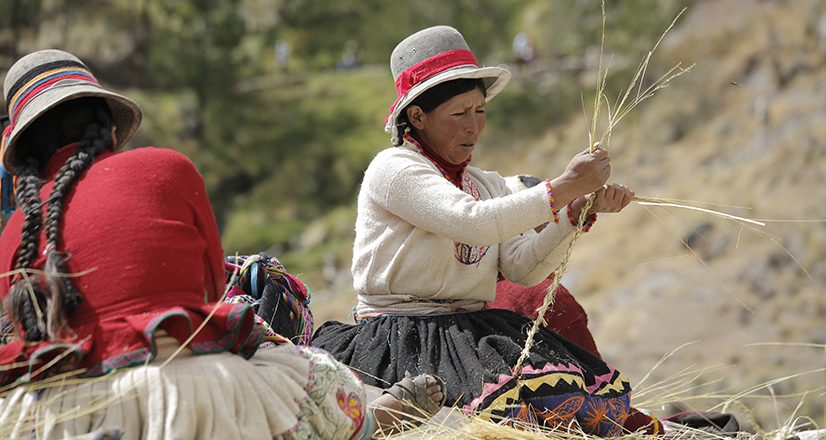
Photo by @PromPeru
Travel Tips for Q'eswachaka Rope Bridge
Visiting the Q’eswachaka Rope Bridge is an opportunity to witness a unique blend of history, culture, and natural beauty. The bridge, an extraordinary piece of engineering, showcases the traditional techniques and communal effort involved in its construction. During the annual festival in June, the area becomes a hub of vibrant activity. The festival features traditional music, dance, and celebrations, offering visitors a glimpse into the rich heritage of the Andean people. The atmosphere is electric, and the sense of community is palpable as everyone participates in the festivities.
Exploring the Area
Beyond the bridge itself, the surrounding area is filled with attractions that beckon exploration. The Apurimac River Canyon, with its dramatic landscapes, provides excellent opportunities for hiking and photography. Trails winding through the gorge offer breathtaking views and a chance to immerse yourself in the natural beauty of the Andes. Nearby villages welcome visitors with open arms, offering a chance to learn about traditional Andean life. You can see locals engaged in their daily activities, participate in workshops, and learn about their customs and crafts. The combination of stunning landscapes and rich cultural experiences makes the region a must-visit for anyone interested in the Andean way of life.
Where to Stay
While there are limited accommodation options directly near Q’eswachaka, nearby towns such as Cusco and Sicuani offer a variety of lodging choices. In Cusco, you can find a wide range of hotels, from budget-friendly to luxurious guesthouses and homestays. Sicuani also offers several comfortable options. Staying in these towns allows you to explore Q’eswachaka at a relaxed pace and provides a comfortable base for visiting other attractions in the region. You can also search for a homestay experience near Q'eswachaka.
What to Bring for a Full-Day Tour from Cusco
When preparing for a visit to Q’eswachaka, it is important to pack appropriately for the high-altitude climate. Here are some essential items you should bring:
- Warm Clothing: Pack layers that can be added or removed as needed to accommodate the temperature variations between day and night. High altitudes can be chilly in the morning and evening, but warm during the day.
- Comfortable Walking Shoes or Hiking Boots: Ensure your footwear is suitable for exploring the rugged terrain and hiking trails. Comfortable shoes will help you enjoy the experience without discomfort or injury.
- Sun Protection: Bring a hat, sunscreen, and sunglasses to protect yourself from the strong Andean sun. The sun's rays are more intense at higher altitudes, making sun protection essential.
- Reusable Water Bottle: Staying hydrated is especially important at high altitudes to prevent altitude sickness. A reusable water bottle will help you carry enough water for the day.
- Camera: Remember to bring a camera to capture the stunning scenery and cultural events. The Q’eswachaka Bridge and surrounding landscapes offer plenty of photo opportunities.
Additionally, you will need a small backpack to carry all your essentials for the day. A backpack will make it easy to keep your hands free and distribute the weight evenly on your shoulders, ensuring you can comfortably carry your items throughout your tour.
Best Tour to Q'eswachaka from Cusco
Visiting Q’eswachaka Rope Bridge from Cusco offers a unique glimpse into Inca engineering and Andean culture. Here’s a concise guide to the best tour:
The best tours to Q’eswachaka from Cusco include several key elements for a comprehensive and enjoyable experience.
- Comfortable Transportation: Look for tours that offer reliable, comfortable transportation, typically in a private vehicle or a well-maintained bus with an experienced driver. The journey to Q’eswachaka takes about 3-4 hours, so comfort is essential.
- Professional Guide: A knowledgeable guide enhances your experience by providing detailed information about the history, culture, and significance of Q’eswachaka. Choose tours with guides fluent in multiple languages and deeply familiar with Andean culture.
- Scenic Stops: The journey to Q’eswachaka passes through stunning Andean landscapes. The best tours include scenic stops along the way, such as the Four Lagoons Circuit, allowing you to enjoy and photograph the beautiful surroundings.
- Cultural Experiences: Some tours offer additional cultural experiences, like visiting local villages. Here, you can interact with residents, learn about their daily lives, and participate in traditional activities, which provides a deeper understanding of Andean culture and traditions.
- Meals Included: Look for tours that include meals, especially a traditional Andean lunch. This adds to the cultural experience and ensures you have the energy needed for the day's activities.
- Guided Tour of the Bridge: Once you reach Q’eswachaka, the best tours include a guided walk across the bridge, explaining its construction and significance. Learn about the annual rebuilding ceremony and the techniques used to maintain this incredible structure.
- Optional Activities: Some tours offer optional activities such as short hikes in the surrounding area or bird-watching in the Apurimac River gorge. These activities can add an extra layer of adventure to your tour.
Sample Itinerary for a Full Day Tour to Q'eswachaka
- 4:00 AM - 5:00 AM: Pick up from your hotel in Cusco.
- 6:00 AM - 9:00 AM: Scenic drive with stops at the Four Lagoons Circuit for photos and sightseeing.
- 9:00 AM - 10:00 AM: Arrival at Q’eswachaka. Introduction and guided tour of the bridge.
- 10:00 AM - 12:00 PM: Free time to explore the bridge and surrounding area. Optional short hike.
- 12:00 PM - 1:00 PM: Traditional Andean lunch provided by the tour.
- 1:00 PM - 2:00 PM: Visit a nearby village to learn about local customs and crafts.
- 2:00 PM - 5:00 PM: Return drive to Cusco with scenic stops along the way.
- 5:00 PM - 6:00 PM: Arrival back at your hotel in Cusco.
Recommended Tour Providers
- TreXpereince: Known for their sustainable and culturally immersive tours, Apus Peru offers a detailed itinerary and knowledgeable guides.
- Ultimate Trekking: Offers well-organized day tours with experienced guides and comfortable transportation.
- Trekero: Focuses on providing authentic experiences and includes visits to local communities.
Choosing the best tour to Q’eswachaka from Cusco involves looking for a tour that offers comfort, cultural immersion, and knowledgeable guidance. With the right tour, your visit to Q’eswachaka will be an unforgettable experience that connects you to the rich history and culture of the Andean people.
Nearby Attractions to the Q’eswachaka Rope Bridge
Exploring the area around the Q’eswachaka Rope Bridge offers visitors a wealth of cultural, natural, and historical attractions. Here are some notable sites and activities you can enjoy near Q’eswachaka:
Apurimac River Gorge
The Apurimac River Gorge, through which the Q’eswachaka Rope Bridge spans, is a breathtaking natural wonder. The gorge provides excellent opportunities for hiking, photography, and bird-watching. The dramatic cliffs and fast-flowing river create a stunning backdrop for outdoor adventures. The deep canyon offers visitors a chance to experience the raw beauty of the Andean landscape, making it a perfect spot for nature lovers and adventurers alike.
Four Lagoons Circuit
The Four Lagoons Circuit is a scenic route that takes visitors through a series of beautiful high-altitude lakes: Pampamarca, Asnacocha, Acopia, and Pomacanchi. Each lagoon has its unique charm and is surrounded by stunning Andean landscapes. The circuit is ideal for a leisurely drive or a more adventurous bike tour, offering plenty of opportunities for photography and picnicking. The serene waters of the lagoons reflect the surrounding mountains, creating picturesque scenes that are perfect for capturing memorable photos.
Raqchi Archaeological Site
Raqchi is an impressive Inca archaeological site located near the town of San Pedro. The site is famous for its massive Temple of Wiracocha, a large rectangular structure believed to have been a religious and administrative center. Visitors can explore the temple ruins, ancient storage structures (qollqas), and an extensive network of terraces and pathways that showcase Inca engineering and architecture. Walking through Raqchi, you can feel the presence of history and imagine the bustling life that once filled these grounds.
Waqrapukara Archaeological Site
Waqrapukara, also known as "Horn Fortress," is an ancient pre-Inca and Inca fortress perched on a rocky outcrop with spectacular views of the surrounding valleys. The site features impressive stone structures, terraces, and ceremonial platforms. It is a challenging yet rewarding hike to reach Waqrapukara, making it a perfect destination for adventure enthusiasts and history buffs alike. The fortress's strategic location offers breathtaking panoramic views that are well worth the effort to reach.
Chonta Canyon
Chonta Canyon is a natural marvel and a prime spot for condor watching. Located near the town of Limatambo, the canyon offers breathtaking views and the opportunity to observe the majestic Andean condor in its natural habitat. The hike to the canyon viewpoint is moderately challenging but provides stunning panoramic views of the canyon and the soaring condors. Watching these magnificent birds glide gracefully through the air is an unforgettable experience.
Village of Checacupe
The village of Checacupe is home to several notable attractions, including a three-tiered colonial bridge built by the Spanish, an Inca rope bridge, and a stone bridge. The village also has a charming colonial church with intricate murals and a small museum displaying local artifacts. Checacupe provides a quaint and culturally rich stop for visitors exploring the region. Walking through the village, you can appreciate the blend of Inca and Spanish influences that have shaped its history.
Sicuani Town
Sicuani is a bustling market town located about 50 kilometers from Q’eswachaka. The town offers various amenities, including restaurants, shops, and accommodations. Sicuani is also known for its vibrant Sunday market, where visitors can experience local Andean culture, purchase traditional crafts, and sample regional cuisine. The market is a sensory delight, filled with the sounds, sights, and smells of traditional Andean life.
Cusco City
While a bit farther afield, Cusco is the primary gateway for travelers heading to Q’eswachaka. The city itself is rich in history and culture, with numerous attractions such as the Plaza de Armas, the Cathedral, Qorikancha (Temple of the Sun), and the San Pedro Market. Cusco serves as an excellent base for exploring the surrounding areas, including the Sacred Valley and Machu Picchu. The city's vibrant energy and rich cultural tapestry make it a must-visit destination.
Tips for Visiting Nearby Attractions
- Plan Ahead: Many of these attractions are in remote areas, so it is essential to plan your visit and ensure you have adequate supplies and transportation.
- Hire a Guide: Local guides can provide valuable insights and enhance your experience by sharing their knowledge of the history, culture, and natural beauty of the region.
- Stay Hydrated: The high altitude can be challenging, so drink plenty of water and take your time to acclimate.
- Respect Local Customs: Always be respectful of local traditions and practices, especially when visiting rural communities and archaeological sites.
By exploring these nearby attractions, visitors to Q’eswachaka can enjoy a well-rounded experience that combines adventure, culture, and natural beauty. Each site offers a unique glimpse into the rich heritage and stunning landscapes of the Andean region, making your visit to Q’eswachaka and its surroundings truly memora
In addition to experiencing the bridge itself, visitors can engage in a variety of activities and adventures in the surrounding area. Hiking trails offer stunning views of the Andean landscapes and opportunities to explore the local flora and fauna. Cultural activities, such as visiting nearby villages and participating in traditional workshops, provide a deeper understanding of the Andean way of life. Adventure enthusiasts can also enjoy bird-watching, nature walks, and photography, capturing the region’s unique beauty and biodiversity. Each activity offers a different perspective on the area's rich cultural and natural heritage.
FAQs About Q'eswachaka Rope Bridge
What is the Q’eswachaka Rope Bridge?
The Q’eswachaka Rope Bridge is an ancient suspension bridge made entirely of woven ichu grass, found in the Canas Province of Cusco, Peru. This bridge spans the Apurimac River and is a remarkable example of Inca engineering. Constructed over 500 years ago, it is the last remaining Inca rope bridge still maintained using traditional methods. Every year, local communities come together to rebuild the bridge, preserving their cultural heritage and demonstrating the enduring legacy of the Inca civilization.
Where is the Q’eswachaka Rope Bridge located?
The Q’eswachaka Rope Bridge is situated in the Canas Province of Cusco, near the Qehue district in Peru. It lies at an altitude of approximately 3,700 meters (12,139 feet) above sea level. This location provides a stunning view of the Apurimac River gorge, surrounded by the dramatic Andean landscape. The remote setting offers visitors a unique opportunity to experience the natural beauty and historical significance of this ancient bridge.
How long is the Q’eswachaka Rope Bridge?
The bridge spans roughly 28 meters (92 feet) across the Apurimac River. Its construction showcases the ingenuity and skill of the Inca people, who used natural materials to create a functional and durable structure. The length of the bridge is impressive, considering it is made entirely of grass and maintained annually using techniques that have been passed down through generations.
How old is the Q’eswachaka Rope Bridge?
The Q’eswachaka Rope Bridge has been continuously reconstructed every year for over 500 years. This practice dates back to the time of the Inca Empire, demonstrating the long-standing cultural importance of the bridge. The annual rebuilding ceremony not only preserves the bridge itself but also keeps alive the traditional knowledge and skills necessary for its construction.
Who rebuilds the Q’eswachaka Rope Bridge?
The bridge is rebuilt each year by the local communities of Huinchiri, Chaupibanda, Choccayhua, and Ccollana Quehue. These communities come together to harvest ichu grass, braid it into ropes, and weave these ropes into the bridge. The process is a collective effort that reflects the Inca principle of ayni, or reciprocal labor. This communal activity strengthens social bonds and ensures the continuity of their cultural heritage.
When is the Q’eswachaka Rope Bridge rebuilt each year?
The bridge is rebuilt every year in the second week of June, culminating on the second Sunday of the month. This timing is chosen to coincide with the dry season, providing favorable weather conditions for the construction. The rebuilding ceremony is a significant cultural event, attracting both locals and tourists who come to witness and participate in this unique tradition.
What materials are used to build the Q’eswachaka Rope Bridge?
The bridge is constructed entirely from ichu grass, a tough, wiry grass native to the high Andes. This grass is harvested, dried, and braided into small cords. These cords are then twisted together to form larger ropes, which are used to create the main structure of the bridge. The natural materials used in the construction highlight the Inca’s ability to work harmoniously with their environment.
What is the significance of the annual rebuilding ceremony?
The annual rebuilding ceremony is a vibrant cultural event that honors ancestral techniques and brings the community together. It is a time for celebration, with traditional music, dance, and rituals that pay homage to Pachamama (Mother Earth) and the Apus (mountain spirits). The ceremony is not just about maintaining the bridge but also about preserving a way of life and reinforcing cultural identity.
Can tourists visit the Q’eswachaka Rope Bridge?
Yes, tourists are welcome to visit the Q’eswachaka Rope Bridge year-round. The annual rebuilding ceremony in June is a particularly special time to visit, as it provides a unique opportunity to witness the traditional construction techniques in action and participate in the cultural festivities. The bridge and its surroundings offer a fascinating glimpse into the rich heritage of the Andean people.
How can I get to the Q’eswachaka Rope Bridge from Cusco?
The Q’eswachaka Rope Bridge can be reached from Cusco by a combination of bus and car rides, typically organized by tour operators. The journey takes about 3-4 hours and passes through scenic Andean landscapes, including the Four Lagoons Circuit. Many tours offer comfortable transportation and include stops at various points of interest along the way, enhancing the overall experience.
What should I bring for a visit to Q’eswachaka?
When visiting Q’eswachaka, it is important to pack appropriately for the high-altitude climate. Essential items include:
- Warm clothing: Layers that can be added or removed as needed.
- Comfortable walking shoes or hiking boots: Suitable for exploring the rugged terrain.
- Sun protection: A hat, sunscreen, and sunglasses.
- Reusable water bottle: To stay hydrated, especially at high altitudes.
- Camera: To capture the stunning scenery and cultural events.
Are there any other attractions near the Q’eswachaka Rope Bridge?
Yes, there are several attractions near Q’eswachaka worth exploring. These include:
- Four Lagoons Circuit: A scenic route passing through four beautiful high-altitude lakes.
- Raqchi Archaeological Site: Known for the Temple of Wiracocha and impressive Inca ruins.
- Waqrapukara Archaeological Site: An ancient fortress with spectacular views.
- Chonta Canyon: A prime spot for condor watching.
- Village of Checacupe: Home to colonial and Inca bridges and a charming church.
Is the Q’eswachaka Rope Bridge safe to cross?
Yes, the bridge is safe to cross. It is tested for strength during the annual rebuilding ceremony and regularly maintained by the local communities. While it may sway slightly, the bridge is designed to be durable and strong, capable of supporting the weight of several people at once.
What is the best time of year to visit Q’eswachaka?
The best time to visit Q’eswachaka is during the dry season, from May to September, when the weather is most stable. June, in particular, is ideal for experiencing the annual rebuilding ceremony, which offers a unique cultural experience and a chance to see the bridge being constructed using traditional methods.
Can I participate in the rebuilding ceremony?
While the actual construction is carried out by the local communities, visitors are welcome to observe and learn about the process. Some tours offer opportunities to engage with the builders and gain insights into the techniques and cultural significance of the bridge.
Are there guided tours available to Q’eswachaka?
Yes, several tour operators offer guided day trips from Cusco to Q’eswachaka. These tours often include transportation, a knowledgeable guide, and visits to other nearby attractions. A guided tour can enhance your experience by providing context and detailed information about the bridge and its cultural importance.
What kind of wildlife can I see near Q’eswachaka?
The area around the Apurimac River gorge is home to various wildlife, including the Andean condor, which is often seen soaring above the canyon. You might also spot other bird species, small mammals, and unique flora that thrive in the high-altitude environment.
Is there accommodation available near Q’eswachaka?
While there are limited accommodation options directly near Q’eswachaka, nearby towns such as Cusco and Sicuani offer a range of lodging choices, including hotels, guesthouses, and homestays. Staying in these towns provides a comfortable base for exploring Q’eswachaka and other attractions in the region.
What cultural experiences can I have near Q’eswachaka?
Visitors can engage with local communities, learning about traditional Andean life, participating in workshops, and visiting nearby archaeological sites. These cultural experiences offer a deeper understanding of the rich heritage and customs of the Andean people.
Why is the Q’eswachaka Rope Bridge important?
The Q’eswachaka Rope Bridge is a living testament to Inca engineering and cultural heritage. Recognized by UNESCO, it serves as a significant symbol of community, tradition, and continuity for the Andean people. The bridge and its annual rebuilding ceremony preserve ancient techniques and foster a strong sense of cultural identity and pride among the local communities.
